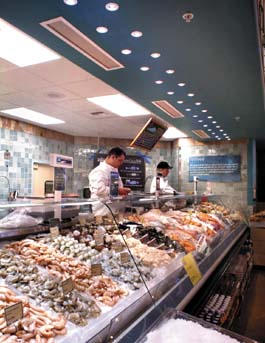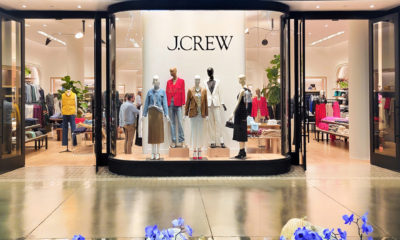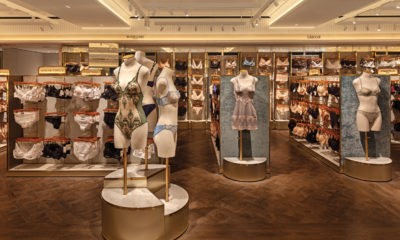Retailers have known for years that lighting can affect food displays, cause premature discoloration and shorten product shelf life. In fact, the National Cattleman's Beef Association estimates that U.S. retailers fail to capture at least $1 billion annually from fresh beef sales due to discoloration.
Less clear, however, may be the notion that lighting can impact the safety of perishable foods, creating potentially toxic situations inside fresh food displays. The impact of this problem may be compounded as food retailers continue to offer more prepared and home-meal replacement foods, trying hard to differentiate themselves from new hypermarket competitors such as Wal-Mart. Supermarkets now go to great lengths to create pleasing displays of convenient, prepared dishes, often under spot and accent lights with extra intensity to draw shoppers' attention.
“I would say 90 percent of lighting in stores is wrong from a food safety and shelf-life perspective,” says Mark Granfar, president, Promolux Lighting Intl., a British Columbia-based lighting manufacturer that has conducted research on issues regarding lighting and food safety. “Lighting can not only increase the physical temperature of food products, but it also acts as an accelerator in the process of oxidation, discoloration and chemical breakdown of almost all food products.”
Granfar points out that the connection between lighting and food toxicity has been of particular interest to universities and research centers for many years. However, the information has failed to trickle down to retailers and lighting designers, where the real impact can be made.
“When you hire a lighting designer, you may be getting someone who knows Kelvin temperature and lumens, not someone who knows food,” says Granfar. “But I think in the future, there are going to be more people specializing in food lighting because there is a multi-billion-dollar problem caused by lighting on food.”
Bright Lights, Big Problem
Food retailers today favor displays with intense bright lighting provided by a variety of lamps, such as HID, metal halide, halogen, fluorescent and incandescent. The understanding is that shoppers are attracted to and prefer bright displays, and will, in turn, buy more.
Retailers and designers know that this lighting emits invisible ultraviolet (UV) and infrared (IR) wavelengths, as well as visible radiation. But what may be far less understood is the effects of these wavelengths on perishable products.
Studies show that visible radiation causes meat to turn from a fresh-looking cherry red color to brown. Various UV wavelengths can cause the fat content in milk to oxidize, turning it rancid. And IR radiation, which produces actual heat, can “cook” products and raise surface temperatures, causing strawberries and raspberries to grow mold or the skin on bell peppers to wrinkle.
Paul Ravenelle, manager, business development for Fiberstars Inc. (Fremont, Calif.), a fiberoptic lighting manufacturer, says his company discovered by accident the link between lighting and toxicity through potatoes.
Ravenelle said his company was installing a fiberoptic lighting system in a supermarket produce department when an inspector from the Idaho Potato Commission told the installer that the system's 150 foot candles would ruin the potatoes within a day. Spuds exposed to the blue/green end of the light spectrum can produce increased levels of Glycoalkaloid solanine, a natural component of potatoes, which at high levels is toxic to humans. This manifests itself in a green appearance on the skin of the potato. The U.S. Department of Agriculture considers a potato that is more than 5 percent green to be damaged.
But fiberoptics filter out all UV and IR radiation. “He checked all of the potatoes and he didn't find any greening,” says Ravenelle.
The discovery has led Green Giant Fresh (which markets a line of fresh potatoes and onions) to conduct its own in-house testing on potatoes and fiberoptic lighting. Ravenelle says the results, which show a significant decrease in greening, may allow retailers to finally take potatoes out of the dark corners of produce departments and put them under accent lights to capitalize on shoppers' impulse buying habits.
Not all damage, however, is being done inside the produce department. Many supermarkets use open cases in their fresh seafood departments that directly expose contents to overhead lighting. Ravenelle says IR radiation can raise temperatures, causing seafood to dry out and fostering bacteria growth, despite efforts by retailers to keep the product on beds of ice.
“A good seafood department should have no smell,” he says. “If it does, what you're smelling is not the fish but rather the bacteria that is building up on the fish.”
Whole Foods Market (Austin, Texas) has taken measures to address the situation, installing Fiberstars' EFO (Efficient Fiber Optic) system in many of its stores, including the seafood department of its Colorado Springs, Colo., store. The system increased the lighting level inside the department without adding heat or UV radiation to the area. “As a consequence, the beds of ice stay fresher longer and the seafood keeps moister and has a longer, more attractive shelf life,” says Ravenelle.
Display case lighting poses another problem to food retailers. According to Granfar, studies show that a temperature increase of just 2 degrees Fahrenheit can cause exponential bacteria growth on seafood. And researchers at Virginia Tech have found as much as a 25-degree Fahrenheit difference between the bottom and top stacks of flounder fillets placed on display ice beds.
“A manufacturer can make a case that is designed for 29 degrees Fahrenheit [the ideal temperature to store seafood], but if the store places a high-intensity discharge (HID) lamp on top of that case to make it brighter, it's adding surface temperature that accelerates food breakdown and bacteria growth,” says Granfar.
Light at the Tunnel's End
What these issues spell out for retailers is not only significant costs, in terms of wasted products and damaged food, but also potential liability, especially as food retailers continue to offer greater selections of prepared foods.
“Consumers can't track a fish's journey to the store or find out how it was stored before they bought it. All they know is that they ate it and got sick,” says Granfar. “So the liability of supermarkets is significant because they are not only delivering the food, they are actually cutting, serving and processing it.”
Granfar says one solution is to replace existing lamps that were never designed for food displays with lamps that filter UV and IR radiation, such as T5 and T8 fluorescents and fiberoptics .
Another idea, he adds, is to dim the general overhead lighting in the perishables department and use a regular amount of case lighting in the area. Otherwise, retailers who increase the lumens in the general area for overall brightness must also increase the amount of case lighting, adding more heat and UV radiation to displays.
“The solution for safety and shelf life of food begins at the design level,” says Granfar.


 Photo Gallery1 week ago
Photo Gallery1 week ago
 Headlines4 days ago
Headlines4 days ago
 Headlines1 week ago
Headlines1 week ago
 Headlines2 weeks ago
Headlines2 weeks ago
 Headlines1 week ago
Headlines1 week ago
 Designer Dozen1 week ago
Designer Dozen1 week ago
 Headlines1 week ago
Headlines1 week ago
 Headlines1 week ago
Headlines1 week ago













